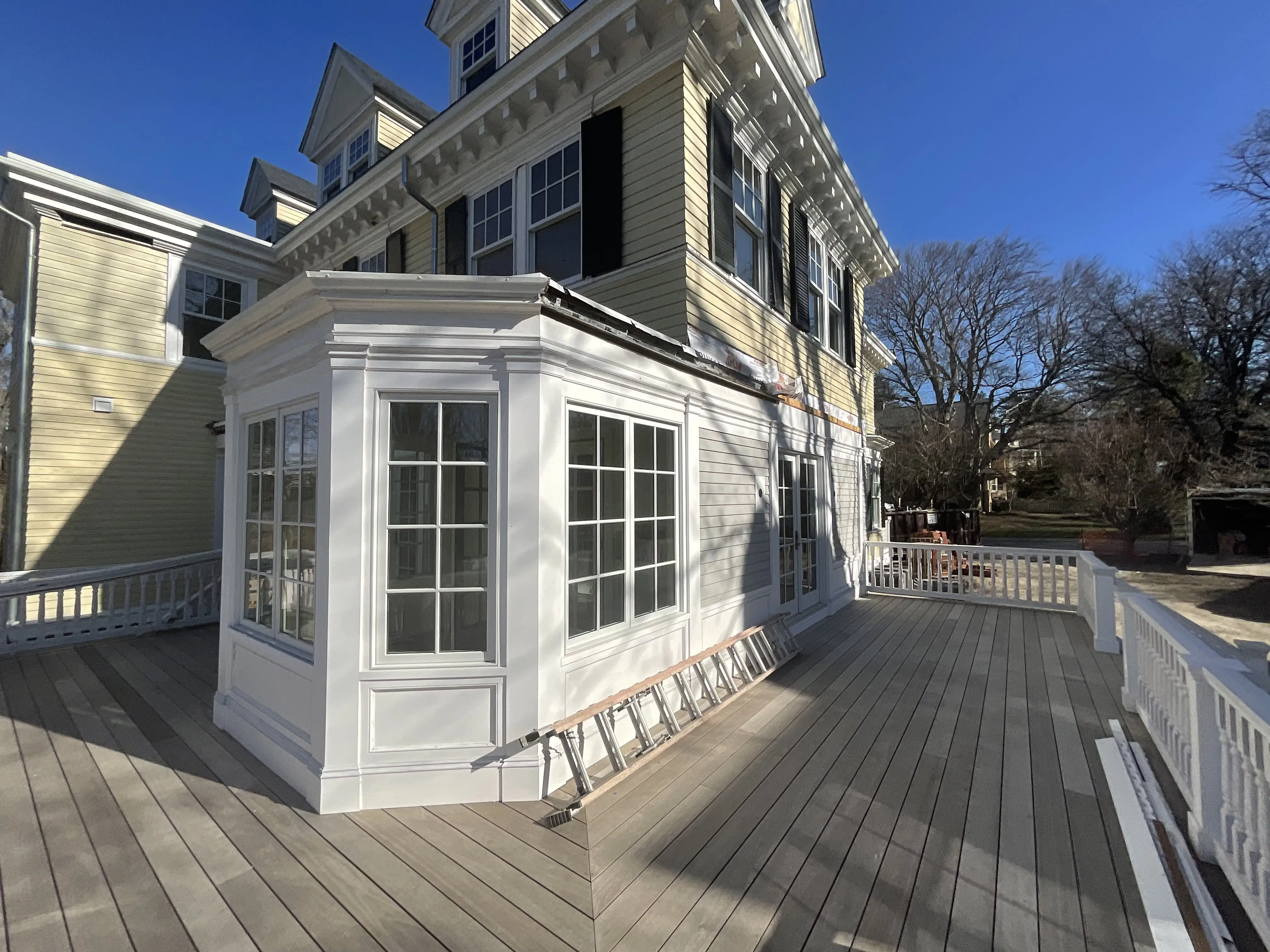Blogs

Best Porch Floor Paint for Wood | Durable & Safe Exterior Options
A wood porch floor is a charming addition to any home, offering a welcoming outdoor living space. However, unlike interior floors, porch floors are constantly exposed to the elements – sun, rain, snow, and foot traffic. This demanding environment means that choosing the right paint isn't just about aesthetics; it's about selecting a durable, slip-resistant, and weatherproof coating that will protect your investment and maintain its beauty for years to come.
Why porch floors need special paint
A standard exterior house paint simply won't suffice for a porch floor. Here's why this surface demands a specialized coating:
Extreme Wear and Tear: Porch floors endure constant foot traffic, furniture movement, and the occasional dropped item. Unlike vertical siding, they are horizontal surfaces that experience direct abrasion.
Direct Weather Exposure: They are fully exposed to rain, snow, ice, and standing water. This constant moisture can lead to wood rot, mildew growth, and paint failure (peeling, blistering) if the paint isn't specifically formulated to handle it.
Intense UV Radiation: The sun's ultraviolet (UV) rays relentlessly beat down on porch floors, causing ordinary paints to fade, chalk, and break down quickly.
Temperature Fluctuations: Wood expands and contracts with changes in temperature and humidity. The paint needs to be flexible enough to move with the wood without cracking or peeling.
Safety: Wet porch floors can become dangerously slippery. Specialized porch and floor paints often include additives or have a natural texture that enhances slip resistance, a crucial safety feature for any outdoor walking surface.
Durability and Adhesion: These paints are engineered for superior adhesion to wood and a tougher film build to withstand the unique stresses of a horizontal, high-traffic outdoor environment.
Features to look for
When selecting the best paint for your wood porch floor, prioritize products that offer specific features designed for this challenging application.
Anti-slip texture
Crucial for Safety: This is perhaps the most important feature, especially in climates prone to rain, dew, or ice.
How it works: Anti-slip properties are achieved either by incorporating fine, gritty aggregates (like silica sand or polymer beads) directly into the paint formula, or by allowing you to add such an additive yourself.
Application: Look for paints specifically labeled as "porch and floor paint" or "deck paint," as these often have built-in anti-slip characteristics. If not, ask your paint supplier for compatible anti-slip additives you can mix in.
Moisture resistance
Repels Water: The paint must form a robust barrier that repels water from penetrating the wood. This prevents rot, mildew, and fungal growth.
Flexibility: It should remain flexible to prevent cracking or peeling as the wood naturally expands and contracts with changes in humidity and temperature. This is where high-quality acrylic or alkyd-modified formulas excel.
Mildewcide: Many high-quality exterior floor paints contain mildewcides, chemical additives that inhibit the growth of mold and mildew, which are common issues in damp, shaded porch areas.
UV protection
Fade Resistance: Direct sunlight can quickly fade colors. Look for paints with strong UV inhibitors that protect the color pigments, ensuring your porch floor retains its vibrancy longer.
Material Degradation Prevention: UV rays also break down the paint film itself, leading to chalking, cracking, and premature failure. Good UV protection ensures the paint remains intact and protective.
Color Choice: Lighter colors generally absorb less heat and reflect more UV light, potentially leading to less fading and degradation over time compared to very dark colors.
Best paint types and brands
For wood porch floors, the consensus among professionals points to specific paint types designed for exterior floor applications.
100% Acrylic Latex Porch & Floor Paint:
Why it's best: This is the most recommended type. High-quality acrylic latex paints offer exceptional flexibility, allowing them to expand and contract with the wood without cracking. They adhere well, resist fading, dry relatively quickly, and are easy to clean up with water. They are also highly breathable, which helps prevent moisture from getting trapped.
Features: Look for products specifically labeled "exterior porch and floor enamel" or "deck paint" that are 100% acrylic latex. Many will have built-in anti-slip additives and mildewcides.
Ideal Sheen: A satin or low-sheen finish is generally preferred for porch floors. It offers durability and ease of cleaning, while being less slippery than a high-gloss finish.
Recommended Brands (Examples):
Sherwin-Williams Porch & Floor Enamel: A very popular and reliable choice known for durability and good adhesion.
Benjamin Moore Floor & Patio Latex Enamel: Excellent reputation for quality, available in a wide range of colors.
BEHR Premium Porch & Patio Floor Paint: A readily available option at home improvement stores, offering good value and performance.
Valspar Porch & Floor Latex Paint: Another common choice that provides good durability and weather resistance.
Alkyd (Oil-Based) Porch & Floor Paint (Less Common Now):
Why it's considered: Historically, oil-based paints were favored for their hard, durable finish. They offer excellent abrasion resistance and can provide a very smooth, tough surface.
Considerations: Oil-based paints are less flexible than acrylics, making them more prone to cracking and chipping as the wood moves. They also have longer drying times, higher VOCs (volatile organic compounds), and require mineral spirits for cleanup. While still available, their use has declined due to environmental regulations and the superior performance of modern acrylics.
Best For: Sometimes chosen for very high-traffic areas or specific historical restorations where an exact match to old finishes is desired, but generally outperformed by modern acrylics for flexibility and ease of use.
Important Note on Priming: Always use a high-quality, compatible exterior wood primer before applying porch and floor paint, especially on bare wood, heavily weathered surfaces, or if you're switching from an oil-based to a water-based paint. Primer ensures proper adhesion, seals the wood, and provides a uniform surface for the topcoat, significantly extending the paint's lifespan.
Application tips for a smooth finish
Achieving a smooth, durable finish on your wood porch floor requires careful application techniques.
Preparation is Key (Again!):
Clean Thoroughly: Pressure wash (on a low setting, with care) or scrub the porch floor with a deck cleaner to remove all dirt, grime, mildew, and loose paint. Rinse thoroughly and allow to dry completely (24-48 hours, or more in humid conditions) before proceeding.
Repair Damage: Fill any cracks, nail holes, or minor imperfections with an exterior-grade wood filler. Sand smooth once dry.
Sand Lightly: Lightly sand the entire porch floor with 80-100 grit sandpaper. This scuffs the surface, creating "tooth" for the paint to adhere to, and removes any remaining loose fibers or old paint.
Clean Dust: After sanding, thoroughly vacuum or sweep away all sanding dust.
Prime: Apply a thin, even coat of a high-quality exterior wood primer compatible with your chosen paint. Allow it to dry fully according to manufacturer instructions.
Check Weather Conditions:
Temperature: Paint when temperatures are within the manufacturer's recommended range (typically 50-90°F / 10-32°C). Avoid extreme heat or direct hot sun, which can cause paint to dry too quickly, leading to brush marks or poor adhesion.
Humidity: Avoid painting during high humidity, as it can extend drying times.
Rain: Ensure no rain is expected for at least 24-48 hours after application to allow paint to cure.
Stir Paint Thoroughly: Before and during application, stir the paint well to ensure all components (especially anti-slip additives) are evenly distributed.
Cut In Edges: Use a high-quality synthetic brush to "cut in" along the edges where the floor meets the house, posts, or railings.
Use a Roller: For the main floor area, use a 3/8-inch nap roller for smooth surfaces or a 1/2-inch nap for slightly textured wood. Roll in long, even strokes, following the grain of the wood.
Work in Manageable Sections: Avoid painting yourself into a corner! Work in sections, starting from the furthest point and working your way towards the exit.
Apply Two Thin Coats: Always apply two thin, even coats rather than one thick coat. Thin coats dry harder, adhere better, and are less prone to cracking or peeling. Allow each coat to dry completely according to manufacturer instructions before applying the next.
Allow Adequate Curing Time: Drying time (when the surface is dry to the touch) is different from curing time (when the paint has reached its full hardness and durability). Avoid heavy foot traffic, dragging furniture, or placing heavy objects on the porch for several days (or even a week) after the final coat, as per paint manufacturer recommendations.
Maintenance and touch-up advice
Even the most durable paint job on a porch floor will benefit from regular maintenance to maximize its lifespan and keep it looking its best.
Regular Cleaning:
Sweep Frequently: Regularly sweep away dirt, leaves, and debris to prevent buildup that can trap moisture and abrade the paint surface.
Occasional Washing: At least once or twice a year, wash the porch floor with a garden hose, a soft bristle brush, and a mild, all-purpose cleaner. For stubborn grime or mildew, use a specific deck cleaner or a diluted bleach solution (1 part bleach to 4 parts water), but always test in an inconspicuous area first and rinse thoroughly.
Avoid Harsh Chemicals: Do not use abrasive cleaners, strong solvents, or harsh detergents, as these can damage the paint finish.
Inspect Annually:
Walk the entire porch floor and visually inspect for any signs of wear: faded spots, small chips, peeling areas, or minor cracks. Pay particular attention to high-traffic zones or areas exposed to the most sun and rain.
Prompt Touch-Ups:
Address small chips or areas of wear as soon as you notice them. Clean the area, lightly sand if necessary, prime if needed, and apply a small amount of matching paint. This prevents moisture from penetrating the wood and causing larger areas of failure.
Keep a small can of your porch floor paint for touch-ups.
Minimize Standing Water:
Ensure proper drainage on your porch. If water tends to pool, address the issue (e.g., improve slope, ensure gutters are clean and diverting water away).
Wipe up spills and standing water promptly, especially after rain or snowmelt.
Protect Furniture Legs: Place felt pads or rubber caps on the feet of porch furniture to prevent scratches and gouges in the paint.
Snow Removal: Use plastic shovels or snow blowers carefully to avoid scraping the paint during snow removal. Avoid using ice melt products directly on the painted surface, as some can degrade paint.
Repaint Cycle:
With proper selection and maintenance, a high-quality porch floor paint job can last 3-7 years before needing a full repaint. Areas with extremely heavy traffic or harsh sun exposure might need refreshing sooner.
Signs like widespread fading, chalking, or minor peeling across a large area indicate it's time for a full repaint rather than just touch-ups.
By investing in the right paint and committing to routine maintenance, your wood porch floor will remain a beautiful, safe, and inviting extension of your home for many seasons to come.
Is your porch floor ready for a transformation that truly lasts? Contact Masterpiece Painter today for an expert consultation and a flawless, durable finish!
About Masterpiece Painter
For over 17 years Masterpiece Painter, has been serving communities all around New England. Let us help you make your wishes come true by turning your property into a Masterpiece
Get a Quote

© copyright 2023 All Rights Reserved.



